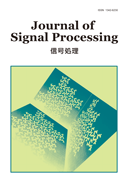All issues

Volume 21 (2017)
- Issue 6 Pages 233-
- Issue 5 Pages 211-
- Issue 4 Pages 121-
- Issue 3 Pages 89-
- Issue 2 Pages 47-
- Issue 1 Pages 1-
Volume 21, Issue 5
Journal of Signal Processing, Vol.21 (2017) No.5 (Editor-in-Chief: Keikichi Hirose, Editor:Yoshikazu Miyanaga, Honorary Editor-in-Chief: Takashi Yahagi)
Displaying 1-2 of 2 articles from this issue
- |<
- <
- 1
- >
- >|
-
Makoto Kobayashi, Kazushi Nakano2017 Volume 21 Issue 5 Pages 211-224
Published: September 15, 2017
Released on J-STAGE: September 15, 2017
JOURNAL FREE ACCESSThe downsampling of a discrete wavelet transform (DWT) has a side effect of the lack of shiftinvariance. There are two main solutions for this effect: one is the stationary wavelet transform (SWT), which does not apply downsampling. The other is the complex DWT (CDWT), which uses dual multiresolution analysis(MRA). We choose the CDWT as a target of research. It is well known that wavelet functions become Hilbert transform pairs if the low-pass filters (LPFs) on the reconstruction side have half-sample shifts. In this paper, we propose a quasi-shift-invariant (QSI) CDWT for bi-/orthogonal wavelets as a new CDWT. We report three new works (W1-W3) on it: (W1) we generalized the condition of Hilbert transform pairs and employed a complex wavelet function as a conjugate analytical signal. (W2) We defined a structure that achieves shift-invariance. The structure requires half-sample delays between the inputs of real and imaginary parts. (W3) We proposed an implementation of the QSI-CDWT and confirmed that our method has higher shift-invariance than the conventional CDWT. However, two problems (P1, P2) remain unsolved: (P1) our method requires more resources, such as memory and calculation time, than the conventional CDWT. (P2) Our theory cannot make all packets shift-invariant in a classical wavelet packet transform tree.View full abstractDownload PDF (891K) -
11. Modifying the Dirac Equation Applicable to Circuit TheoryNobuo Nagai, Takashi Yahagi2017 Volume 21 Issue 5 Pages 225-231
Published: September 15, 2017
Released on J-STAGE: September 15, 2017
JOURNAL FREE ACCESSIn Session 8, we demonstrated that circuit theory can be applied to the Schrödinger equation, a basic equation in quantum mechanics. In this session, we attempt to apply circuit theory to the Dirac equation using the Riccati differential equation and demonstrate that physical phenomena such as spin 1/2 can be explained on the basis of circuit theory. To this end, we obtain the one-dimensional Dirac equation for the complex equivalent circuit for a physical phenomenon. We show that the Dirac equation can be regarded as a type of low-energy effective field theory in quantum theory and that circuit theory can be applied to the Dirac equation.
View full abstractDownload PDF (496K)
- |<
- <
- 1
- >
- >|